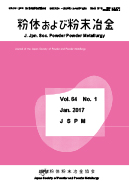
- |<
- <
- 1
- >
- >|
-
Yoshitaka KITAMOTO2017Volume 64Issue 2 Pages 45-
Published: February 15, 2017
Released on J-STAGE: March 04, 2017
JOURNAL OPEN ACCESSDownload PDF (185K) -
Katsuyoshi KONDOH2017Volume 64Issue 2 Pages 46-
Published: February 15, 2017
Released on J-STAGE: March 04, 2017
JOURNAL OPEN ACCESSDownload PDF (189K) -
Toshiyuki NISHIMURA2017Volume 64Issue 2 Pages 47-
Published: February 15, 2017
Released on J-STAGE: March 04, 2017
JOURNAL OPEN ACCESSDownload PDF (219K) -
Hideaki MATSUBARA2017Volume 64Issue 2 Pages 48-
Published: February 15, 2017
Released on J-STAGE: March 04, 2017
JOURNAL OPEN ACCESSDownload PDF (184K) -
Shigeru KATSUYAMA2017Volume 64Issue 2 Pages 49-
Published: February 15, 2017
Released on J-STAGE: March 04, 2017
JOURNAL OPEN ACCESSDownload PDF (246K) -
Naoyuki NOMURA2017Volume 64Issue 2 Pages 50-
Published: February 15, 2017
Released on J-STAGE: March 04, 2017
JOURNAL OPEN ACCESSDownload PDF (205K) -
Tadayuki TSUTSUI2017Volume 64Issue 2 Pages 51-
Published: February 15, 2017
Released on J-STAGE: March 04, 2017
JOURNAL OPEN ACCESSDownload PDF (199K) -
Hideaki MATSUBARA2017Volume 64Issue 2 Pages 52-
Published: February 15, 2017
Released on J-STAGE: March 04, 2017
JOURNAL OPEN ACCESSDownload PDF (162K)
-
Kazumichi NAKATANI2017Volume 64Issue 2 Pages 55-60
Published: February 15, 2017
Released on J-STAGE: March 04, 2017
JOURNAL OPEN ACCESSABSTRACTThe filling density in production becomes stable after it decreases rapidly in the initial stage of the consecutive compacting. Flowability fluctuation caused by history of powder movement was assumed to be one of the causes and experiments were conducted with pre-mixed powder of Fe-2 mass%Cu-0.9 mass%C-0.8 masss%Lubric ant. The experiments of this work verified that filling density is greatly affected by the history of the powder movement right before filling. Based upon the results, a highly precise filling system was developed. The new system enabled to abolish adjustment of compacting condition and to reduce defective compacts.
View full abstractDownload PDF (833K) -
Makoto KOBASHI2017Volume 64Issue 2 Pages 61-67
Published: February 15, 2017
Released on J-STAGE: March 04, 2017
JOURNAL OPEN ACCESSABSTRACTPorous metals exhibit various unique physical and mechanical properties, such as low bulk density and high strain energy absorbing capability. The optimum shape of the pores (cell morphology and topology) depends on the required properties. In this paper, two processing methods (precursor method and reactive precursor method) and some attempts to control the cell structure are discussed. Porous aluminum alloys are fabricated by the precursor method. In this method, powder compacted precursor consisting of aluminum and titanium hydride powders are prepared. Upon heating the precursor, titanium hydride decomposes and releases hydrogen gas at around the melting point of aluminum. Then the hydrogen gas produces many pores in aluminum. As for the reactive precursor method, the precursors are made by blending at least two kinds of reactive elemental powders (e.g. aluminum and titanium powders). Closed, flat-disc, open, bimodal-sized and high-porosity open pores are currently achieved by the reactive precursor method.
View full abstractDownload PDF (3707K)
-
Yuuki TAKAMURO, Takashi TERANISHI, Hidetaka HAYASHI, Akira KISHIMOTO2017Volume 64Issue 2 Pages 68-72
Published: February 15, 2017
Released on J-STAGE: March 04, 2017
JOURNAL OPEN ACCESSABSTRACTAiming for an application to the high temperature pressure sensor, semiconductive ceramics foam incorporated with a narrow slit has been fabricated by our innovated superplastically foaming method. We investigated the pressure dependence of resistance on the zinc oxide based foaming body, by changing the fabrication process and composition. The resistance of the sample decreased with an increase in pressure both at room and high temperatures. The performances of this type of sensor such as sensitivity and linearity have been improved by doping ambivalent atoms (Ag and Li) into the matrix.
View full abstractDownload PDF (998K) -
Taku IWAOKA, Yukiko OZAKI, Akira FUJIKI2017Volume 64Issue 2 Pages 73-79
Published: February 15, 2017
Released on J-STAGE: March 04, 2017
JOURNAL OPEN ACCESSABSTRACTThe evaluation of ejection behavior is important to the final formability of green compact because both the ejection and the compression in the powder die compaction are affected by die wall friction. In other words, there is a hysteretic relationship between the lateral pressure and compacting pressure. In this paper, the effect of powder characteristics on the ejection die wall friction was studied using a powder model that considers the hardness and shape of the powder. The ejection behavior was classified on the basis of the powder’s characteristics coefficient drawn from the model. Next, the influence of the particle size distribution, in addition to that of the hardness and shape of the powder, on the ejection behavior was shown.
View full abstractDownload PDF (1053K)
-
2017Volume 64Issue 2 Pages Pref2_1-
Published: February 15, 2017
Released on J-STAGE: March 04, 2017
JOURNAL OPEN ACCESSDownload PDF (149K)
-
Junko UMEDA, Takanori MIMOTO, Hisashi IMAI, Katsuyoshi KONDOH2017Volume 64Issue 2 Pages 81-87
Published: February 15, 2017
Released on J-STAGE: March 04, 2017
JOURNAL OPEN ACCESSCorrigendum
ABSTRACTThe recycling process of the machined chips from the commercial Ti-6%Al-4%V (Ti-64) alloys to raw powders was established through the combination of brittle TiH2 compounds formation via heat treatment in hydrogen gas atmosphere and fragmentation by ball milling technique. TG-TDA and XRD analysis obviously suggested the hydride and dehydride behavior of pure Ti and TiH2 powders. The suitable heat treatment temperature at 873 K or more in H2-Ar mixed gas successfully caused the formation of TiH2 compounds, and resulted in the fragmentation of Ti-64 machined chips to powders with a median particle size of 120 µm, which were completely consolidated by pressing. In addition, the original machined chips never remained in the ball-milled machined chips after heat treated over 873 K. The green compact after vacuum sintering at 1273 K showed a relative density of about 93%, larger than that of the sintered material in using the commercial Ti-64 powders.
View full abstractDownload PDF (1360K)
- |<
- <
- 1
- >
- >|